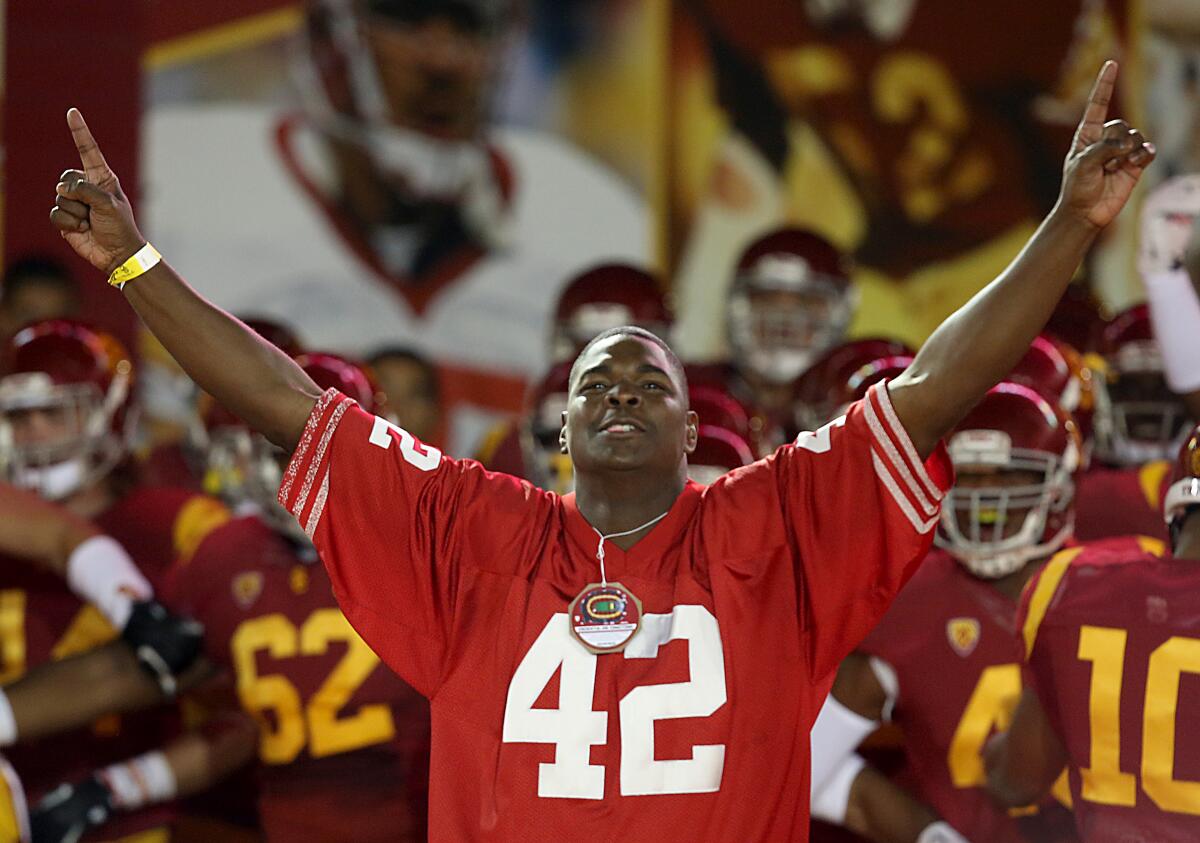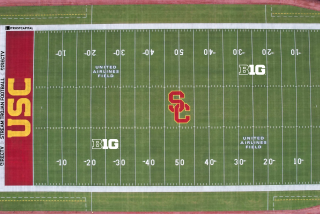Column: 15 minutes of fame flies by. Who can help student-athletes cash in?

- Share via
Demand for Yeezys recently spiked for a large reseller of high-end shoes and clothing … much to my chagrin.
Apparently some people consider them to be a collector’s item despite (or because of) the well-known antisemitic musings of its creator, formerly known as Kanye West. So while it’s been reported Adidas — which severed its relationship with Ye because of his offensive remarks — is sitting on $500 million worth of Yeezys it can’t move, that reseller called Impossible Kicks is shuffling up to 7,000 pairs a month out the door, some for as much as $400.
I want you to keep all of that in mind as you ponder this question:
How much do you think a 2006 Tim Tebow shoe would go for today, had he been able to sell items during the frenzy that surrounded him at Florida for four years? You know, like everyone else did.
Opinion Columnist
LZ Granderson
LZ Granderson writes about culture, politics, sports and navigating life in America.
If Yeezys can still move after all of the controversy, if a pair of shoes Michael Jordan wore as a rookie can go for nearly $1.5 million, Tebow would have brought new meaning to the phrase “big man on campus” had student-athlete name/image/likeness deals been a thing when he was at his most popular.
That was always the sticking point for me in the ongoing debate about student-athlete compensation. There is such a small window of time for college kids to take advantage of their fame — 15 minutes, as the saying goes — and the NCAA owned every second. When TV deals started to exceed eight figures, to pretend this arrangement was equitable would be Gaslighting 101.
That’s not to say NILs are perfect. Between shady third-party collectives and different states having different rules, there will always be a degree of chaos to it. But the thing is there was always chaos — with recruitment violations and boosters hovering around campuses. At least now future Tebows can make some money in the midst of the chaos.
And the fact there are still coaches out there lamenting that lost “amateur” fairy tale is ridiculous. Not everyone is going to make millions in the pros. For most student-athletes, this is the end of the road for their athletic career.
There’s this 15-year-old quarterback in Georgia by the name of Julian “JuJu” Lewis who has more than 100,000 followers on Instagram, north of 200,000 likes on TikTok, and is already drawing comparisons to Trevor Lawrence, the top overall pick in the 2021 NFL draft. Why shouldn’t he turn that social media presence into coin like other influencers his age? Lewis also has 35 scholarship offers, including from USC, which has an athletic department that isn’t fond of outside NIL collectives but did set up an in-house shop last June — BLVD, which has since fizzled.
Last month, the Tommy Group, fronted by former USC great Keyshawn Johnson, officially launched as an outside collective for USC players … after already having begun working with 80 student-athletes. Among those is Caleb Williams, who has been able to cash in on his likeness while in college, unlike Tebow.
Or think about Johnny Manziel, who became the first freshman to win the Heisman back 2012. He was nicknamed “Johnny Football” in high school but didn’t trademark it until he left Texas A&M. By then the lion’s share of his 15 minutes were behind him, and with it huge earning potential. Sure, he and Tebow still got drafted in the first round and signed contracts worth millions. But what about the millions left on the table when they were in college? Or more accurately, the millions that ended up in someone else’s pockets while they were off being “amateurs”?
When Johnson told me about the Tommy Group, I was excited to see my friend use his expertise to help Trojans like Williams make the money he didn’t make when he was in college. Representation matters, and I think it’s a win-win situation whenever NFL greats like Johnson and Drew Brees, who joined an NIL collective at his alma mater Purdue, give back in this way. In a lot of ways, they are the only ones who can really understand what a student-athlete like Williams is going through.
Case in point: The Athletic conducted a survey of NFL agents regarding their thoughts on NIL, and one of them said “the problem is you’re seeing a lot of unqualified people that are out there taking advantage of these young men.”
First of all, that’s rich coming from an agent.
Second, former college stars with NFL careers are among the most qualified folks to show the younger versions of themselves how to maximize their 15 minutes (if college is indeed the end of their fame).
Maybe that’s why Tebow was among the speakers at the NIL Summit in Atlanta last year, to give the next Heisman winner a heads-up on the things he’s learned.
Johnson told me his group’s intent isn’t to make money for themselves but rather to look out for what’s best for Trojans. And considering how many times this lifelong Trojan has yelled “Fight On” in my face, I believe him.
More to Read
A cure for the common opinion
Get thought-provoking perspectives with our weekly newsletter.
You may occasionally receive promotional content from the Los Angeles Times.












